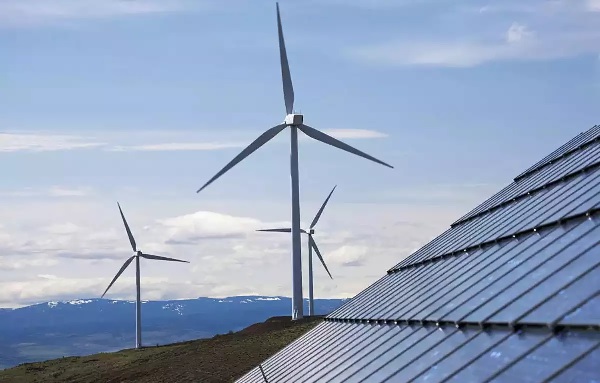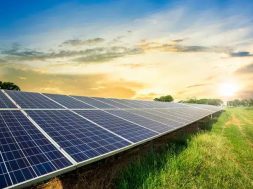
In Short : Karnataka is advancing its renewable energy mission with plans to add 38 GW by FY35, nearly half by FY30. Key projects include the 2,050 MW Pavagada Solar Park and a 300 MW hybrid project in Gadag and Koppal. With a focus on solar, wind, and battery storage, Karnataka remains a frontrunner in India’s clean energy push.
In Detail : Karnataka with a total installed renewable power capacity of 23,017.97 GW (as of January 31, 2025), has the fourth highest installed renewable energy capacity in the country after Rajasthan, Gujarat and Tamil Nadu. Of this, approximately 9,282.19 MW comes from solar projects and 6,851.90 MW from wind projects. This makes up 70.1 per cent of its total renewable power capacity. The remaining is contributed by biopower (1,909.95 MW), large hydro (3,689.2 MW) and small hydro (1,284.73 MW). The solar capacity is further segmented into 8,478.43 MW of ground-mounted solar, 683.60 MW of rooftop solar, 39.16 MW of off-grid/KUSUM components and 81 MW of hybrid solar components. The biopower capacity comprises 1,868.91 MW of biomass power/bagasse cogeneration, 20.2 MW of non-bagasse biomass cogeneration, 1 MW of waste-to-energy (WtE) and 19.84 MW of off-grid WtE components. The state has the fifth highest overall solar power capacity, and the third highest overall wind power capacity. Further, it is among the few states in India that have consistently met its renewable purchase obligation (RPO) targets.
Key developments
Karnataka’s journey towards clean energy began with the setting up of the first hydroelectric power generation station at Shivanasamudra in 1902. Over the years, the state has diversified into different renewable energy sources, especially solar power. The key highlight of Karnataka’s solar segment is the 2,000 MW solar power park in Pavagada, Tumkur, which was commissioned in 2018. Several MW-scale solar parks have been approved by the state at various locations, including Bidar and Madhugiri.
The state was an early mover in the Indian renewable energy landscape and has gained prominence through its well-executed policies, programmes and implementation. It exceeded its solar target of 6 GW by 2021 and has several GWs of additional renewable capacity planned for completion by 2030. To achieve this, the Karnataka Energy Department has introduced an ambitious initiative to transition millions of irrigation pumps to solar power, aiming to significantly reduce annual subsidy expenditures. Additionally, the state government is advancing efforts to harness solar energy from its waterbodies. Three key departments – Minor Irrigation, Water Resources, and Karnataka Renewable Energy Development Limited (KREDL) – are collaborating to establish floating solar parks. While still in its early stages, the project has generated enthusiasm, opening up promising opportunities for renewable energy to enhance self-sufficiency in micro-communities.
The department has identified 40 lakes, each spanning over 100 acres and managed under the Lift Irrigation Scheme. Collectively covering nearly 10,000 acres, these lakes have the capacity to generate approximately 2,500 MW of electricity. In the initial phase, the project will be implemented in five districts – Bengaluru Rural, Bengaluru Urban, Ramanagara, Kolar and Chikkaballapura – where perennial water supply is being explored through nearby lift irrigation projects. The goal of this initiative is to lower the irrigation department’s electricity expenses for irrigation projects.
Other key initiatives in the state’s solar segment in the past year include the Karnataka Solar Power Development Corporation’s bid invitation in February 2024 to set up a 300 MW grid-connected solar project. To be located at the Pavagada solar park, the project has an estimated cost of Rs 8.93 billion. In the same month, the state government, during its budget, announced plans to install 40,000 off-grid solar pump sets under Component B of the Pradhan Mantri Kisan Urja Suraksha evam Utthaan Mahabhiyan (PM-KUSUM) scheme. The estimated cost of this initiative is Rs 11.74 billion. In July 2024, KREDL issued a request for proposal to select a developer to commission a 100 MW grid-connected ground-mounted solar project and a 50 MW/130 MWh battery energy storage system. To be located in Kalaburagi district of Karnataka, the project is estimated to cost Rs 5.63 billion. Moreover, in September 2024, Orkla India entered into a partnership with CleanMax for the supply and generation of solar energy from a 6.6 MWp solar power plant in Jagaluru, Karnataka. In December 2024, Hero Future Energies commissioned a 29 MWp solar project in Chitradurga, Karnataka, targeting the commercial and industrial (C&I) sector.
Beyond its solar advancements, the state secured second place in the all-India wind energy generation capacity commissioned for the year 2023-24. The state came second after Gujarat. As per data from KREDL, the commissioned capacity for wind power generation for FY2023-24 is 1,027.04 MW from 44 projects. This momentum has been driven by key industry developments in the sector, which have continued post FY2023-24 as well.
Furthermore, the state is focusing on clean energy by promoting green hydrogen across industries and the mobility sector. With plans to introduce fiscal incentives, Karnataka is gearing up to launch a dedicated green hydrogen policy. Through this initiative, it aims to attract strategic investments that align with the transition to green hydrogen, reinforcing its commitment to sustainable energy. The state’s efforts in the segment are reflected in various initiatives undertaken over the past year. In February 2024, KREDL decided to set up a 300 kW self-sustained green hydrogen plant in the state. The project will be taken up on a pilot basis at a cost of Rs 100 million. KREDL is considering Pavagada and Kalaburagi as potential sites for the project. In November 2024, Hero Future Energies signed an MoU with the Karnataka government to invest Rs 110 billion in renewable energy and green hydrogen. The investment will be utilised for establishing projects related to renewable energy and green hydrogen and its derivatives projects in the state over the next two to three years. The proposed initiatives will begin in 2025-26.
Further, Karnataka is making efforts in the hydro space to enhance its renewable energy capabilities. As of June 30, 2024, according to the Lok Sabha, Karnataka’s conventional large hydro potential is 4,414 MW and pumped storage plant (PSP) potential is 7,600 MW. Meanwhile, its small-hydro potential is 3,726.49 MW. As of December 12, 2024, the state has one hydro project, including pumped storage, under construction with a capacity of 2,000 MW. Additionally, two projects with a combined capacity of 1,900 MW are under survey and investigation.
Policy developments
Karnataka was one of the first states in India to take the lead in policy impetus for the renewables sector with the introduction of the Karnataka Renewable Energy Policy, 2009-14. This policy played a key role in the state’s renewable energy expansion, resulting in an additional 2,014 MW of capacity over five years. To further tap into its solar potential, the state government introduced the solar policy for 2011-16, which was later revised and reissued as the Karnataka Solar Policy, 2014-21. This updated policy set a goal of developing 6,000 MW of solar capacity by 2021. Karnataka not only met but exceeded this target, achieving an installed capacity of 7,523 MW by December 2021. Continuing its commitment to renewable energy, the state has now envisioned the Karnataka Renewable Energy Policy, 2022-27, aiming to further accelerate clean energy adoption and sustainable development. According to the policy, Karnataka is aiming for a renewable power generation capacity of 10 GW in the next five years. Rooftop solar alone is expected to account for at least 1 GW by 2027. Several renewable energy parks, including hybrid ones, will be built in the state. This initiative aims to make Karnataka a manufacturing hub for renewable energy equipment.
The state has been introducing progressive policies to drive innovation and sustainability. The Karnataka Electricity Regulatory Commission (KERC) unveiled the KERC (Implementation of Peer-to-Peer Solar Energy Transaction) Regulations, 2024. These regulations, applicable to all distribution licensees and eligible consumers in Karnataka, aim to streamline the trading of rooftop solar energy using blockchain-based platforms.
Moreover, in December 2024, KERC issued a directive to make it easier for consumers with sanctioned loads of up to 10 kW to adopt rooftop solar systems. The directive focuses on important aspects such as increasing capacity, simplifying approval processes and ensuring technical flexibility. Additionally, in January 2025, the KERC released the draft KERC (Terms and Conditions for Open Access) Regulations, 2025. This draft outlines a proposed framework for accessing electricity transmission and distribution systems in Karnataka. It aims to replace the previous green energy open access rules and introduce an all-encompassing set of regulations for all open access consumers, including those sourcing green energy. The regulations cover both short-term and long-term open access.
Outlook
Karnataka boasts an impressive renewable energy potential, with 24.7 GW of solar power, 124.15 GW of wind power at 120 metres and 169.3 GW at 150 metres. Additionally, the state has potential of 1 GW from biomass, 135 MW from municipal solid waste and 2 GW from cogeneration in sugar industries. Despite these substantial resources and the ambitious target of adding 20 GW of renewable energy capacity, challenges persist. In recent years, the number of new renewable energy projects in the government sector has significantly decreased. According to KREDL data, renewable energy projects with a combined capacity of 1,317.36 MW were commissioned in 2019-20, but this dropped to just 236.83 MW in 2020-21. Although there has been a slight uptick in projects commissioned since 2020-21, the numbers have remained close to 500 MW.
Going forward, the pace of renewable capacity additions must align with the new RPO trajectory, which will be uniform across all states. In line with the RPO trajectory decided by the central government, in November 2024, KERC introduced new renewable energy goals for the state, aiming for 43.33 per cent of total energy consumption to be sourced from renewables by 2029-30. A draft notification outlined a progressive rise in RPO targets for distribution licensees, captive consumers and open access consumers.
On a positive note, there has been substantial growth in interstate transmission infrastructure for renewable energy plants in recent years. Unlike the state’s previous (2014-21) solar policy, the new renewable energy policy removes restrictions on the maximum size of solar parks at specific locations. To this end, in July 2024, the Karnataka government planned to establish yet another solar park in Madhugiri taluka. The solar park will be developed in a strategic partnership with THDC India Limited.
As Karnataka charts its course towards renewable energy goals, the road ahead will require careful navigation of several challenges. To fully unlock the state’s immense potential in various segments, there is a pressing need for tailored policies that will accelerate progress. For this vision to succeed, these policies must not only be well crafted but also effectively implemented. Furthermore, the state government recognises that collaboration is key. Continued efforts, particularly through partnerships with the central government and private sector through public-private partnerships, will be essential in overcoming hurdles and driving the transition forward.













